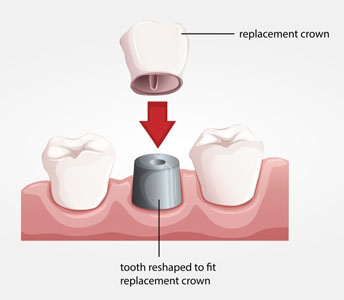 We use crowns and bridges to repair damaged teeth at our Wantagh dentist office. Crowns, which are also known as dental crowns or dental caps by popular culture, are the most popular way of fixing damaged teeth. When we combine multiple crowns with your natural teeth, we create dental bridges. We use both crowns and bridges to repair teeth. These treatment options serve to address the three main problems that occur with broken teeth. The three problems with broken, cracked, or chipped teeth are the vulnerability, functionality, and aesthetic value.
We use crowns and bridges to repair damaged teeth at our Wantagh dentist office. Crowns, which are also known as dental crowns or dental caps by popular culture, are the most popular way of fixing damaged teeth. When we combine multiple crowns with your natural teeth, we create dental bridges. We use both crowns and bridges to repair teeth. These treatment options serve to address the three main problems that occur with broken teeth. The three problems with broken, cracked, or chipped teeth are the vulnerability, functionality, and aesthetic value.
Fight against infection
Speaking of vulnerability, most people do not realize that their mouth is actually awash with multiple kinds of oral bacteria. This bacteria is what causes decay and bad breath; however, under normal circumstances, it has no access to the soft inner part of the tooth, which is called the pulp. When you have a broken tooth, the bacteria can much more easily get to the tooth’s pulp or even the root and cause a serious infection.
To prevent this, it becomes essential to quickly seal up the damage with crowns and bridges at your dentist.The second challenge with damaged teeth is that they are no longer able to perform their core function, which is to chew and help you digest your food. Teeth are designed to tear and break down food, making it essential that as we treat them. We will provide you with an excellent chewing device and an undamaged chewing surface on one or multiple teeth with the help of crowns and bridges.
Finally, it is important for people to look good and smile confidently. We know that a confident smile cannot happen with broken, cracked, chipped, or damaged teeth. To that end, having us place a crown or bridge will give a patient back the aesthetic value of his or her teeth.
Crown and Bridges
When we are placing crowns and bridges, we will begin with a comprehensive preparation stage. What this entails depends on several factors, like how many teeth we need to replace, the material we will be using for the crowns, and what other fillings we have to remove.
When placing dental crowns, one of the added procedures that often becomes necessary is a root canal if the tooth has an infected root. Then we would need to shave away the enamel so the crowns can properly fit over the tooth and be secure. At the same time, we would want to remove any damaged or decayed enamel. Several things we pay close attention to at the dentist office are margins and cusps.
The margin is the smooth edge of the new dental crown that would meet the gum. It is essential that these are smooth, with no gaps or ledges. We also pay close attention to the cusps, which are the pointy part of the tooth essential for chewing. If you have a damaged cusp on your natural teeth, you will need dental crowns to replace them.
Related Posts
Coronavirus (COVID-19) Prevention Efforts and Emergency Dentistry Care
Due to the coronavirus disease (COVID-19), the American Dental Association has released guidelines for dental practitioners across the country. As of March 16, 2020, it is recommended that dentists delay all nonessential treatment and perform …
Emergency Dentistry and the Coronavirus (COVID-19) Disease: Is a Broken Tooth Considered a Dental Emergency?
As you think about emergency dentistry and the Coronavirus COVID-19 disease, you may wonder when you can still go to the dentist. Health and government leaders have closed many businesses to promote social distancing. However, …
Types of PPE per CDC Guidance Used by Dental Professionals at Park Avenue Dental
Dentists protect themselves from bacteria and viruses by using PPE per CDC guidance. The CDC has outlined different types of personal protection equipment (PPE) dentists should use. The CDC has announced more guidelines during the …
How Dentists Protect Themselves From Infectious Disease Using PPE per CDC guidance
Dentists use PPE per CDC guidance to protect themselves when performing dental procedures. Personal protective equipment, or PPE, includes gowns, gloves and masks. The CDC has general guidelines for dentists and PPE. Also, it has …
